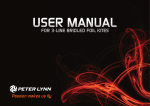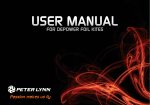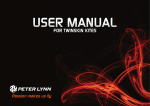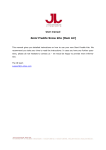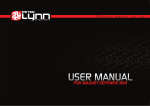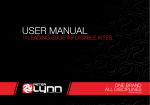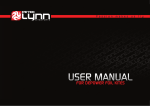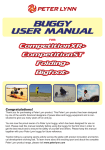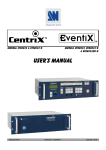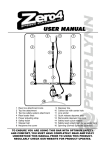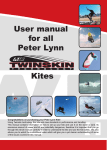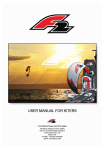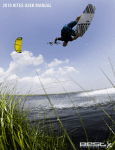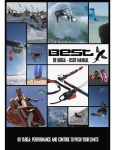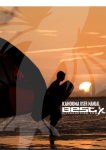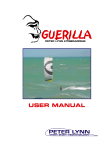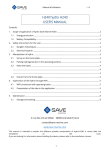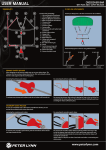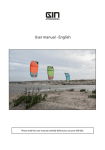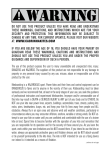Download manual - Peter Lynn
Transcript
WELCOME Thank you for buying this Peter Lynn product and welcome to the world of Peter Lynn; a world of wind driven excitement, where people passionately pursue their dreams. Whether that’s riding huge waves with your kiteboard on a beautiful island, freeriding at your local beach on a landboard or going for the buggy speed record on a deserted salt lake, Peter Lynn is here to help you pursue your dream. Are you ready to achieve your ultimate challenge? Peter Lynn has been taking challenges from the early days of the sport. Challenges to come with better products, invent new solutions, improve peformance and build superior quality in every aspect of those products. We bring kites for all kite disciplines, for all terrains, for all conditions. All this come forth from a passionate crew of kite sports enthusiasts and we invite you to join us. It’s that passion that makes us fly. Before any attempt to use this product, please ensure you pay full and careful attention to the contents of this manual. While kiteboarding is an exciting and fun sport, it can be highly dangerous for yourself and others around you, especially if the necessary safety precautions are not or only partly taken. Aside from thoroughly reading this manual, we recommend proper instruction from a certified kiteboarding school. This manual has been designed to supplement kiteboarding lessons, not to replace them. So please make sure you learn to kiteboard in a safe way. Only then you will progress quickly and enjoy this beautiful sport to the max. Enjoy! PACKAGES The Navigator is available in two different models; the Navigator SL and the Navigator TS. Check the specifications of your kite to see which model is recommended for your kite. Each bar model has different packages, each offering a certain combination of bar size and corresponding length of the supplied flying lines. By making use of the extension flying line set as well as the dual bar size endcaps, the bar can be adjusted to fly better on smaller or larger kites. Safety instructions CAUTION: Kite powered sports can be very dangerous and physically demanding. The user of this product should understand that participating in kite powered sports may involve serious injury or death and agrees to observe the safety precautions listed below. Safe location and weather conditions: • Stay away from power lines, roads, airfields, railway lines, trees and buildings. • Never launch your kite in crowded areas. Do not fly your kite over bystanders. • Make sure there is a ‘clear’ downwind area at least three times the distance of your flying line length. • Never fly kites or use this product in thunderstorms, lightning or gusty/stormy winds. • Never fly a kite or use this product with wind forces so strong that you are unable to maintain full control of your kite and its power at all times. • Do not fly a kite or use this product when wind conditions are likely to change dramatically. • Stop kiting immediately when a storm or lightning is approaching. • Make sure you are familiar with the location and local customs and laws before attempting any kind of kite sports. Safe traction kiting: • A traction kite is not a toy and should not be flown by inexperienced persons and certainly not by children. • Learn to fly kites by starting in light winds with a small sized kite. • Never use any type of kite or this product for paragliding, parachuting or base jumping. • Never use any type of kite or this product for jumping off high places like hills or cliffs • Never use any type of kite or this product for any manlifting activity. • Always use fully protective gear when kiteboarding, landboarding, snowkiting or buggy riding. Safe kiteboarding: • Do not go kiteboarding in offshore winds. • Be careful when kiting in onshore winds. • We strongly recommend the use of helmet and life jacket/impact vest. A safety knife to cut flying lines in case of emergency is recommended. • Do not kiteboard in spots already in use by swimmers or surfers. • Beware of strong currents and sharks. • Stay safely away from other watercrafts and shipping lanes. • Never go further out to sea than you can safely swim back. • Always make sure there is a capable person on shore that is keeping watch and is ready to provide (or call for) help in case of an emergency. • We strongly recommend taking lessons from a certified kiteboarding school before using this kite on your own. Safety issues when using this product: • This kite has been manufactured with high quality materials and has been manufactured using the latest and most advanced production methods. • Prior to every use of this product, fully check your equipment for any signs of wear and tear. Replace parts immediately where needed. • Prior to every use of this product, check if your safety releases are still working properly and you are aware how to use it. In case the safety release does not work as it should, do not use this product and replace parts where needed. • Only use this product for kiteboarding, buggy riding, landboarding and snowkiting. • Do not use this product when your body weight is over 130kg (285lbs). • Only use this product when you are in a good state of health. Never use this product when under the influence of alcohol, drugs or medication. • Do not alter, modify or change this product. Repairs should be done by a professional kite repair shop, sail repair shop, or by the Peter Lynn company. Terminology NAVIGATOR SL 1 2 2 3 4 Navigator SL terminology 1. Rear flying line connector 2. Top flying line connector 3. Top flying line, upper segment 4. Rear flying line 5. Top flying line segment connection 6. Top flying line, lower segment 7. Top line connection point 8. Center top line 9. Safety line 10. Top ring of the power adjuster 11. Depower/adjuster line 12. Leader line 13. Self-landing handle 14. Power adjuster cleat 15. Free sliding stopper 16. Floater 17. Dual size endcap with integrated bungee chord 18. Tapered bar with EVA foam finger grip 19. Centrix depower loop with safety release 20. Removable depower loop lock-in pin 21. Safety leash 22. Harness attachment with quick release 1 3 5 5 6 4 6 7 9 11 12 14 13 16 15 8 10 12 13 16 11 17 17 18 19 21 Accessories supplied with the bar 23. Suicide leash adapter 24. Safety line extension 25. Flying line extension set 20 22 23 24 25 26 27 28 30 29 31 32 33 34 Centrix terminology 26. Dual depower line 27. Safety line running through depower loop 28. Swivel 29. Centrix main body 30. Safety release pin 31. Safety release cuff 32. Safety leash attachment loop 33. Depower loop tube 34. Removable depower loop lock-in pin Terminology NAVIGATOR ts 1 2 2 3 Navigator TS terminology 1. Rear flying line connector 2. Top flying line connector 3. Top flying line, upper segment 4. Rear flying line 5. Top flying line segment connection 6. Top flying line, lower segment 7. Safety line 8. Top ring of the power adjuster 9. Depower/adjuster line 10. Leader line 11. Self-landing handle 12. Power adjuster cleat 13. Free sliding stopper 14. Floater 15. Dual size endcap with integrated bungee chord 16. Tapered bar with EVA foam finger grip 17. Centrix depower loop with safety release 18. Removable depower loop lock-in pin 19. Safety leash 20. Harness attachment with quick release 1 3 4 4 5 5 6 7 8 10 9 12 11 13 14 10 11 14 Accessories supplied with the bar 21. Suicide leash adapter 22. Safety line extension 23. Flying line extension set 11 15 15 16 17 19 18 20 21 22 23 24 25 26 28 27 29 30 31 32 Centrix terminology 24. Dual depower line 25. Safety line running through depower loop 26. Swivel 27. Centrix main body 28. Safety release pin 29. Safety release cuff 30. Safety leash attachment loop 31. Depower loop tube 32. Removable depower loop lock-in pin Primary Safety release When things get out of hand you might want to use your safety release. The Navigator control bar has a primary release on the depower loop. After activating the release, the kite is only supported by the safety line . Activating the primary quick release Re-connecting the primary safety release To activate your primary quick release, pull the red release cuff part down towards your spreader bar. Re-connect the primary safety release by placing the pin inside the Centrix center piece, flipping the pin over and sliding the release cuff over the pin. Always make sure all parts are free of sand and snow before re-connecting your safety system. Secondary quick release In case you completely want to disconnect yourself from the kite, you can activate the secondary quick release afterwards. Activating the secondary quick release Re-connecting the secondary quick release To activate your secondary quick release, move the red release cuff away from the large stainless steel ring. Re-connect the secondary safety release by placing the pin through the ring, folding the pin back up and sliding the red release cuff over the pin. Make sure the release cuff is sitting right against the ring after reconnecting. Safety leash preparation When using your Navigator for the first time, attach the webbing loop on the end of the leash to your harness. Make sure to attach it to a well reinforced part of your harness, such as a large solid ring, a handlepass leash chord running from one side to the other, a grab handle or the spreader bar itself. You can leave the leash on your harness at all times. Before starting your kiting session attach the clip on the end of the leash to the small loop at the end of the safety line. The ‘Suicide Leash’ adapter If you prefer a suicide leash setup when doing unhooked tricks, it is recommended to use the SL adapter. Using this adapter, you are still able to activate your standard safety system when you are riding hooked in. When letting go of the bar while being unhooked, the kite will keep its shape and the bar will stay closer to the rider, for a faster recovery. Standard safety leash setup ‘Suicide leash’ safety setup For standard safety system, attach the safety leash to the loop at the end of the red safety line. There is no need to use the SL adapter for this setup. Attach the larger ring of the SL adapter to the depower loop tube. Attach the safety leash to both the smaller ring of the SL adapter and the loop on the end of the safety line as shown. CAUTION! The ‘suicide leash’ setup is for expert riders only! Use it at your own risk. Do not use a suicide leash in unpredictable wind conditions or when riding overpowered. Options for safety systems - navigator sl only! The Navigator SL features two options for your safety system: Standard - Safety line attached to both top lines Extra safety - Safety line attached to single top line safety line extension safety line • • • • safety line connects to the flying lines at top line connection point Kite will lose most of its power. Kite will drop from the sky towards the edge of the wind window. Kite will have little power when lying on the water. Very fast and easy recovery, bar does not slide very far from rider. safety line connects to the flying line where two segments meet safety line • • • • Kite will lose all of its power. Kite will drop from the sky and will lay on its back. Kite will have very little power when lying on the water. Slightly more difficult recovery, bar slides further away from rider. Options for safety systems - navigator sl only! Attaching the additional safety line extension for safety line on single top line Step 1 Step 2 Step 3 top flying line upper segment top flying line lower segment center top line Step 4 Step 5 top flying line upper segment and lower segment are disconnected safety line extension center top line attached to flying lines lower segment top flying line upper segment is connected with top flying line lower segment and safety line extension safety line extension attached to safety line safety line EN FLY Ds IN OF G to LI NE p s top l ine lowe s segm r ent cent e & sa r top fety line line At the top line connection point, remove the top flying lines by sliding the ends of the flying lines through the loops on the end of the safety line and center top line. end lin of e e s af xt en et y sion center top lin e to pf lin lyin es g Re-connect the top flying lines at the top line connection point. s af e t y lin e x te n s e ion EN D to lin p f se e u lyin gm pp g ent er sa e f et lin y et nsion f s a x te e yl ine OF FLY top ING LI N E to pf l se low yin gm e g entr lin e Add the safety line extension to Remove the upper segment the disconnected safety line. of one of the top flying lines by sliding the end of the flying lines through the loop of the lower segment of the flying line. s af et y & to line fly p ing Low line seg er me nt top flying line upper segment top f uppe lying lin r seg e ment Reconnect the upper segment of the flying line to the lower segment and the extended safety line. Depower loop lock-in pin Swivel After hooking in your depower loop, you can use the security pin to prevent your depower loop from accidentally unhooking from your spreader bar. Place the lock-in pin through the spreader bar hook, just below the depower loop tube. The top section of the Centrix depower loop is fitted with a swivel to unspin your front lines. To prevent any wear and tear, as well as any malfunctioning of the safety system, regularly unspin your front lines by using the swivel. If desired, the lock-in pin can be removed from the depower loop tube. For instructions how to remove your lock-in pin, please check the section ‘replacing depower loop tube’ later on in this manual. Using the power adjuster Stopper To set the overall power of the kite, you can use the power adjuster. The free sliding stopper allows you to reduce or increase the amount of bar movement along the depower line. The stopper can be placed at any position, and has been designed to be moved and set during your session with ease. To reduce the overall power of the kite, pull in the line coming out of the adjuster cleat. Move the stopper to the desired position by sliding it along the depower line by hand. To increase the overall power of the kite, pull the line slightly towards you and move it away from the cleat. Now let the line out and let it lock back into the cleat at the desired position. When pushing your bar against the stopper, the line will jam inside the center hole of the bar. Using the flying line extension set By adding or removing extension lines, you can change the handling and power of the kite. Setup without extensions line connectors Attaching the flying line extensions step 1 step 2 Setup with extensions ecto conn line connectors FLY LI NE ion lin OF G en s e flying lines D EN IN OF E E N D N G LI N I FLY Remove the connectors on the end of the flying lines. step 3 l of end ension t x e ine extension line EN D O F NE FLYING LI • less power • more direct steering • smaller wind window • more explosive lift • more power • less direct steering • larger wind window • more float e xt extension set flying lines r Place the loop on the other end of the extension line through the loop on the end of the flying line. Slide the complete extension line through. Slide the loop on the end of the extension line over the loop on the end of the flying line. step 4 ecto r conn of lin end nsion te ex e Re-attach the connectors to the end of the flying lines using the same method. Changing bar size Self-landing handles Your bar can be set to be used in two different bar sizes, adjusting your bar to kite size and wind speed. If you want to land your kite by yourself you can land it using the safety system. If you prefer to land it on a rear line, you can use the self-landing handles. To change the setting, undo the larkshead just below the floaters. Now place the larkshead to the same line, just on the other side of the endcap. Make sure to do do both sides of the bar! First grab the self landing handle, then fully disconnect yourself from the kite. Make sure to disconnect both the depower loop and the safety leash! Packing up After finishing your kiting session, you can wind the lines onto the bar ends. Secure the lines by using the bungee chords. Removing depower/adjuster line If your depower/adjuster line is worn it is recommended to replace it. This will ensure maximum safety and rider comfort. Slide the line out of the stopper. Remove the two screws from the swivel on the Centrix depower loop. Slide the swivel cap up. Undo the depower line from the Centrix depower loop. Slide the line through large ring with Velcro, the black section of the clamcleat, the top ring and the adjusting section of the clamcleat. Place the depower line around the two metal pins as shown. Make sure it is as close to the center pin as possible. Slide the swivel cap over the metal center piece. Make sure no line is caught between the metal and plastic. Using the screws, secure the swivel cap. Place the stopper in the line by placing it in the slits and sliding it in from top to bottom. Placing depower line Slide the line through the adjusting section of the clamcleat and top ring. Now place the line through the black section of the clamcleat. Make sure the clamcleat is placed just below the stitching of the double section. Replacing depower loop tube Maintenance The depower loop tube can be replaced if worn, it can be replaced by a longer version, or it can be taken off to remove the depower loop lock. Take proper care of your equipment! This will help your bar to last a lot longer. • Make sure you regularly check your bar for wear and tear. Make sure to check your depower loop, depower loop tube, depower/adjuster line, adjuster, safety line, endcaps, flying lines and sleeves on the flying lines. Replace parts when needed. There should be a large amount of replacement parts available at your local dealer. • Before launching, always check that your quick releases are in working order. Undo the screws on the Centrix body. Remove the screws completely, then pull the tube out of the Centrix body. Slide the new tube back in place. Make sure the holes of the Centrix body are aligned with the holes in the tube. This can be done by using the Allen key as shown. Make sure the holes are free of dirt, and replace the screws with great care, to prevent damages to the Centrix body. Make sure that the screws are in all the way so they are aligned with the plastic surface. • When reaching the water, before starting your kiteboarding session, splash some water on your bar to rinse off sand that has stuck to it. Also when using your bar on land, after launching wipe as much sand off your bar as possible. Especially remove sand from the depower loop, depower/adjuster line, center hole in your bar, stopper and adjuster. Also get rid of any sand on the safety line on the section next to the depower line. • After every session, rinse your bar with tap water to remove the salt from the bar. Make sure your depower loop, depower/adjuster line, stopper and adjuster are free of sand. Warranty Peter Lynn warrants this product, when it is purchased from an authorized Peter Lynn dealer by a retail customer, to be free of major defects in material or workmanship to the original purchaser, for a period of six (6) months from the date of purchase by the original retail customer. This warranty is subject to the following limitations: • The warranty is solely for the benefit of the original retail purchaser and may not be assigned. For retail customer warranty claims, proof of purchase from an authorized Peter Lynn dealer is required. If the date of purchase can not be established, Peter Lynn will make a determination based on the last production year and/or the condition of the particular product claimed. • The warranty on this product is valid only when it is solely used for designated purposes c.q. kiteboarding on water and does not apply to any product used for rental and/or teaching purposes. • Peter Lynn will make the final warranty determination, which may require inspection and/or photos of the equipment. Photos must clearly show the defect(s). If necessary, this information must be sent to the Peter Lynn dealer where the product was originally purchased, postage prepaid. Alternatively you may contact the Peter Lynn distributor in (or nearest to) your country. • If a product is deemed to be defective by Peter Lynn, the warranty covers the repair or replacement of the defective product only. Peter Lynn will not be responsible for any costs, losses, or damages incurred as a result of loss of use of this product. This warranty does not cover damage caused by misuse, abuse, neglect or normal wear and tear including, but not limited to, damage due to excessive sun exposure, use in combination with other than Peter Lynn control gear, damage caused by improper handling and storage, damage caused by use in waves or shore break, and damage caused by anything other than defects in material and workmanship. • The warranty is voided if any unauthorized repair, change or modification has been made to any part of the equipment. The warranty for any repaired or replaced equipment takes effect from the date of the original purchase only.The original purchase receipt must accompany all warranty claims. The name of the Peter Lynn dealer and the date of purchase must be clear and legible. • There are no warranties which extend beyond the warranty specified herein. Warranty Claims Warranty claims must be processed through an authorized Peter Lynn dealer and be issued a return authorization prior to shipping the product concerned. For claims processing please contact the Peter Lynn dealer the product was purchased from or call - or write to - the national Peter Lynn distributor. If there is no Peter Lynn distributor in your country, please find our contact details on our website www.peterlynn.com. DISCLAIMER – RELEASE OF LIABILITY Peter Lynn / Vliegerop Ltd - Release of Liability Caution Before making any attempt to set up or use this product, you agree to have read and fully understood the entire Peter Lynn Navigator user manual; including, but not limited to, all instructions and warnings it contains. You also agree to make sure that any other user of this Peter Lynn product, prior to using it, will also read and fully understand this Peter Lynn Navigator user manual; including, but not limited to, all instructions and warnings it contains. Assumption and acceptance of risk Kite powered sports can be very dangerous and physically demanding. While powerkiting in its many forms is an exciting and fun sport, it can be highly dangerous for yourself and others around you, especially if the necessary safety precautions are not or only partly taken. The user of this Peter Lynn product should understand that participating in kite powered sports can result in serious personal injury – and even death – to the user as well as to third parties. Before setting up and using this Peter Lynn product you agree to assume and accept any risk of injury, whether known or unknown, to both yourself and any third parties from using this Peter Lynn product. To reduce these risks, we strongly recommend you to stick to the safety precautions listed in this Peter Lynn user manual. Disclaimer and Release of Liability Concerning the purchase of this Peter Lynn product by you, you hereby agree, to the greatest extent allowed by law, to waive any claims you have or may have in the future against Peter Lynn and all related entities resulting from using this Peter Lynn product and/or any of its components. You will also release Peter Lynn and all related entities from any liability for special, indirect, incidental, consequential or exemplary damages, whether in contract, tort, negligence, strict liability or otherwise including, but not limited to, loss of property other than this Peter Lynn product, loss of use of this product, or other property or other economic losses. Peter Lynn shall not be liable for contribution or indemnification, whatever the cause. All terms and conditions contained herein shall, in the event of your death or incapacity, apply and be binding upon your heirs, next of kin and any other representatives including, but not limited to, administrators and executors. The foregoing provisions regarding liability and warranty are exclusive and in lieu of all other liability- and warranty statements, whether written, oral or implied. scan QR code for more info www.peterlynn.com Find us on Facebook www.facebook.com/peterlynncom Follow us on www.twitter.com/peterlynncom
















